Executive Summary
Opponents of education choice often make two arguments about its effect on rural areas: (1) Education choice will not help in rural areas because there are few or no alternatives to the district school system, and (2) education choice will destroy the district school system because so many students will leave for alternative options. These two claims are mutually exclusive. They cannot both be true, but they can both be—and indeed are—false.
The dearth of education options in rural areas has been greatly exaggerated. About seven in 10 rural families live within 10 miles of a private elementary school. Children in rural areas can attend charter schools in states with policies that have fostered the creation of charters in rural areas. In Arizona, more than eight in 10 students live in the same zip code as at least one charter school. Rural areas are seeing the rise of microschools, a modern reimagining of the one-room schoolhouse. Additionally, high-quality virtual schools are available to anyone with a decent Internet connection—which is becoming increasingly available in rural America. Families in rural areas have access to more education options than ever before.
The most recent data from the National Assessment of Educational Progress for Arizona—the state with the greatest access to education choice—do not support the claim that education choice has been harmful to the rural district schools. Indeed, the best available evidence indicates that education choice is the rising tide that lifts all boats.
Policymakers who want to increase education options for rural families should enact education choice policies, such as K–12 education savings accounts, and broaden charter school laws to make it easier to open them in rural areas.
Introduction
When Lisa and Leonard Biehl visited Mormon Lake in Arizona—renowned for its breathtaking scenery as well as its hiking and fishing—they fell in love with the place. A few years later, in March 2021, they made it their permanent home. Leonard found a job as a firefighter and Lisa worked at home.
The Biehls just had one challenge to overcome—enrolling their three children, ages five, seven, and 10, in school. Mormon Lake Village is a rural community, so small that it does not have its own public school. Many families there send their children to the closest public school system in Flagstaff, about 30 miles away. However, while Flagstaff provided buses for high school students in the Biehls’ area, there was no public transportation for K–8 students. The prospect of driving two 60-mile roundtrips a day, five days a week, to take their children to school was highly impractical, so the Biehls sought other education options.
Fortunately for them, Arizona has a vibrant education sector with a plethora of options. A family friend told the Biehls about Sequoia Choice, an online charter school, and they decided to give it a try. “Our kids are learning a lot,” says Lisa. “It’s a little bit tougher than [what] they were used to, and there’s a lot of content, but they’re settling in nicely. They understand what they have to do and, for the most part, they’re pretty independent.”
The Biehls soon found that they enjoyed the freedom and flexibility that online learning afforded them. There is no set schedule, so their children can take breaks when they want to, and it is easier to plan family vacations or go on impromptu outings. Most of the classes are pre-recorded and students can arrange one-on-one time with teachers via Zoom. Despite the lack of in-person instruction, Lisa says that her children are receiving more personal attention than when they attended public schools. They enjoy it so much that they do not want to return to a traditional classroom environment.
Education in Rural America
According to the most recent data, about 14 percent of the U.S. population lives in rural areas, down from 16 percent in the 2000 census.REF As shown in Chart 1, according to the most recent data from the National Center for Education Statistics, about 85 percent of rural K–12 students in America attend a public school, either assigned or chosen (such as charter schools, magnet schools, or out-of-district public schools).REF Similar to urban areas, about 10 percent of rural students attend a private school. Nearly 5 percent of rural students are homeschoolers, which is about twice the proportion of students in cities, suburbs, and towns.
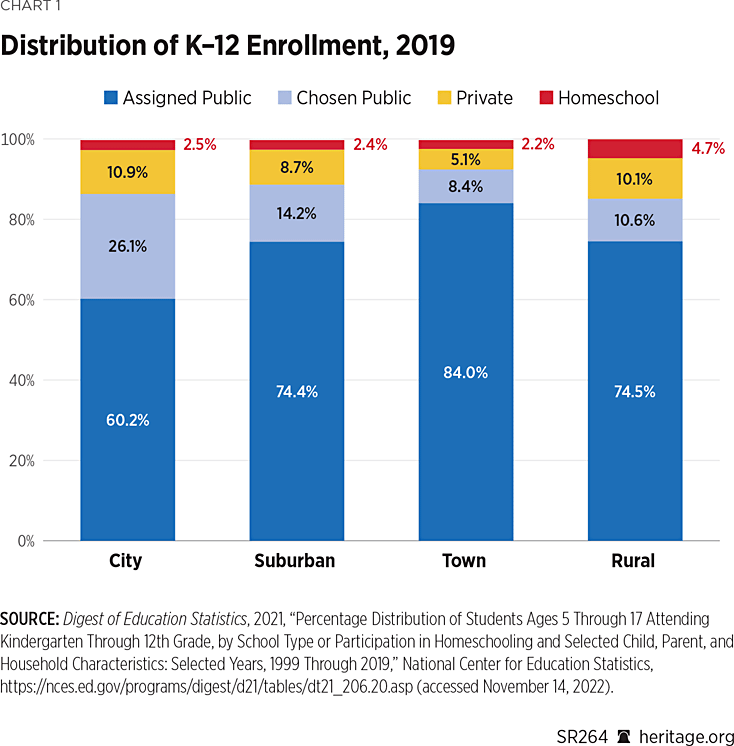
What constitutes a rural area? The U.S. Census Bureau defines “rural” as “any population, housing, or territory NOT in an urban area.”REF As “urbanized areas” have populations of 50,000 or more, and “urban clusters” have populations between 2,500 and 50,000 residents, that means that the Census Bureau considers all areas with populations below 2,500 residents to be rural. However, other definitions abound. Agencies across the federal government use more than 70 different definitions of “rural.”REF
As Michael McShane and Andy Smarick note in their book, No Longer Forgotten: The Triumphs and Struggles of Rural Education in America, perhaps “a better understanding of rurality is cultural.”REF
Rural communities share several common characteristics. They are often small and close-knit. Generally speaking, a significant portion of the community is in some way tied to the land—through farming, mining, drilling, or something similar. And, they are typically isolated. Major cultural and civic institutions are more frequently found in cities and suburban areas with more population density—meaning rural families need to travel some distance to take advantage of large hospitals, professional sports stadiums, shopping malls, and the like.REF
Of course, rural areas also differ from each other. An Appalachian coal mining community, a Navajo reservation in the Sonoran Desert, oil drillers in the frozen tundra of Alaska, and potato farmers in Idaho might all live in rural areas, but their communities and cultures are distinct. Nevertheless, they face many similar challenges related to access to education, reliable Internet service, and transportation options.
Rural Americans also share many concerns with their urban counterparts. According to a recent study by the Pew Research Center, similar proportions of urban residents (50 percent) and rural residents (46 percent) say that drug addiction is a major problem in their local community. Rural adults are somewhat more likely to say that job availability is a major problem (42 percent), but a considerable share of urban residents (34 percent) and suburban residents (22 percent) say the same.REF
Still, some challenges are more acute in some areas than in others. According to Pew, rural Americans are more likely than urban dwellers to list as pressing problems access to public transportation (43 percent vs. 19 percent) and access to high-speed Internet (24 percent vs. 13 percent). Both of those challenges can, in turn, reduce access to a wide variety of education options.
Rural communities also have distinctive strengths. For example, rural residents are more likely to know and trust their neighbors. About four in 10 rural residents say that they know all or most of their neighbors, while less than a quarter of city dwellers say the same. More than six in 10 Americans in rural areas have a neighbor they would trust with a set of keys to their home, compared to fewer than half of urbanites.REF Rural residents are also more likely than urbanites to say that they are satisfied with their family life (49 percent vs. 43 percent). Families in rural areas can draw on this greater fount of social capital when seeking to overcome the challenges described above.
The Pandemic and the Rise of Education Choice
In the wake of the COVID-19 pandemic, parents nationwide awakened to the need for education choice. Whether frustrated by unnecessarily long and union-driven school shutdowns, low-quality instruction via Zoom video, or the general lack of responsiveness of their assigned schools to their children’s needs, parents realized that their children would be better off with more education options.
There is a growing disconnect between parents and public schools over the values taught in school.
Parents also got a peek inside the classroom and were often disturbed by what they saw. In a 2022 poll commissioned by the American Federation for Teachers—one of the nation’s two largest teachers’ unions—44 percent of respondents in seven key battleground states said that they believed that “[p]ublic schools often go too far in promoting a political agenda in the classroom.”REF When asked to list their top four “biggest problems” in education from a list of 12 possible concerns, half of respondents expressed concern that “education has become too politicized”—more than any other issue. When asked who was to blame, one-third said that “Democrats and liberals are more responsible,” while 28 percent blamed Republicans and conservatives.
There is a growing disconnect between parents and public schools over the values taught in school. In a 2022 Pew survey, only half of public school parents said that the teachers and administrators at their child’s school share their values, compared to eight of 10 private school parents.REF
The disconnect over values is especially frustrating for parents who feel stymied in their attempts to influence what their children learn in public schools. Only 38 percent of public school parents expressed high satisfaction with the level of input they have on what their children learn in school.REF By contrast, 61 percent of private school parents were extremely or very satisfied with their level of input.
The level of parental satisfaction with their children’s school quality also varies considerably by sector. In the Pew survey, eight of 10 parents of children enrolled at private school expressed strong satisfaction with the quality of their child’s education, while only 55 percent of public school parents were very satisfied.REF (See Chart 2.)
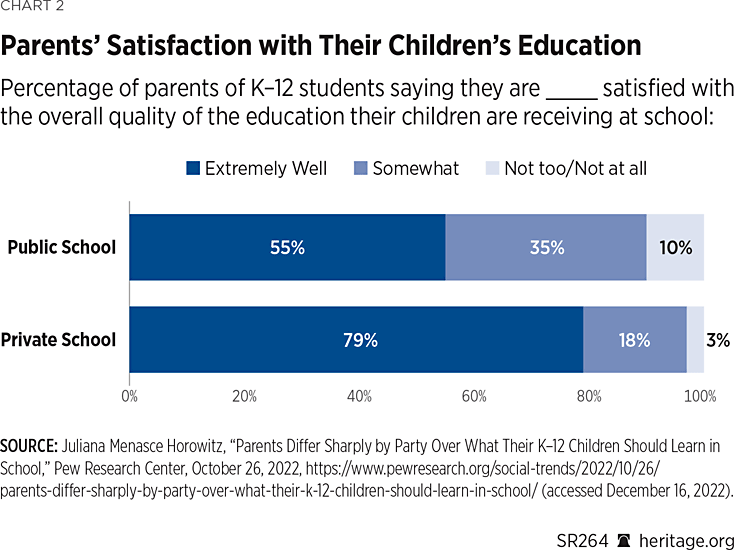
These frustrations over educational quality and content in traditional public schools have translated into record-high levels of support for education choice policies, which empower families to choose the learning environments that align with their values and best meet their children’s individual learning needs. Public support for education choice policies—such as K–12 education savings accounts (ESAs), school vouchers, and tax-credit scholarshipsREF—was already high and rising even before the pandemic, but the public school system’s response to COVID-19 accelerated the trend. As shown in Chart 3, 74 percent of respondents to a June 2021 RealClearOpinion poll supported school choice policies that give “parents the right to use the tax dollars designated for their child’s education to send their child to the public or private school which best serves their needs,” up from 68 percent in the year before the pandemic.REF
Support for choice policies is strong in rural areas, too. In the March 2022 Texas Republican primary, Proposition 9 asked voters whether “Texas parents and guardians should have the right to select schools, whether public or private, for their children, and the funding should follow the student.”REF Voters answered in the affirmative by a margin of 88 percent to 12 percent. Some of the highest levels of support came from the most rural counties in Texas, including Culberson (97 percent), Edwards (89 percent), Kent (87 percent), McMullen (90 percent), Kenedy (100 percent), Roberts (87 percent), and Terrell (90 percent).
Likewise, a survey conducted in January 2022 found that 70 percent of rural Oklahomans supported school choice, while only 25 percent opposed it.REF School choice garnered even higher levels of support among Oklahoma Republicans (78 percent) and earned the support of a plurality of the state’s Democrats (47 percent). Contrary to the conventional wisdom that public school employees uniformly oppose school choice, the poll found that current public school employees in Oklahoma were evenly split on the issue (45 percent both in favor and opposed), while former public school employees were more inclined to support school choice (56 percent in favor versus 41 percent opposed).
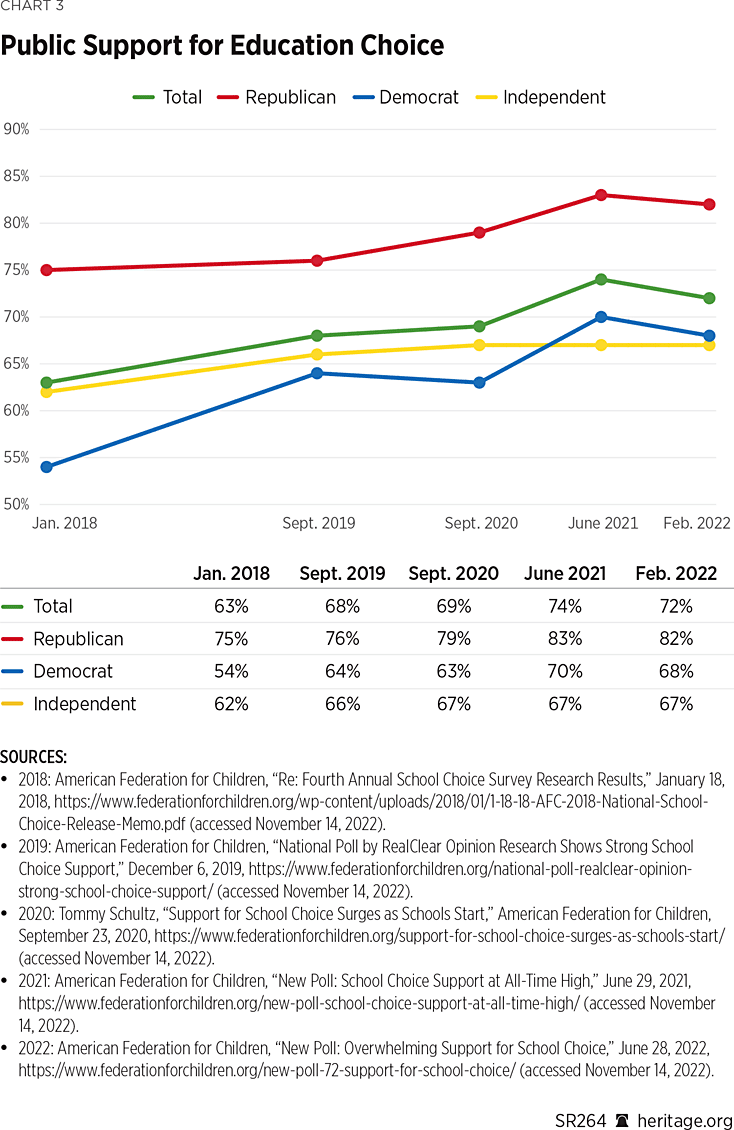
High levels of support for education choice policies have, in turn, translated into historic legislative victories. In 2021, 19 states enacted seven new education choice policies and expanded 23 existing ones.REF Not only was this a record high in terms of quantity, but the quality of the legislative proposals also exceeded that of previous years. Whereas most of the existing education choice policies had been limited to certain needy populations, like low-income families or students with special needs, the 2021 proposals tended to make education choice available to a larger swath of the public.
The most expansive education choice policy enacted in 2021 was in one of the nation’s most rural states. West Virginia’s Hope Scholarships, K–12 ESAs that parents can use to customize their children’s education, are available to all West Virginia students who are either switching out of a public school or entering kindergarten.
Kentucky and Missouri also enacted ESA policies that are available to about half of families in each state.REF Florida and Indiana each expanded both their tax-credit scholarship and school-voucher programs so that more than 60 percent of Floridian students and nearly 80 percent of Hoosier students are eligible. New Hampshire enacted an ESA for which about one-third of students are eligible. Oklahoma increased the number of students who could receive a tax-credit scholarship more than seven-fold. As a result of the legislation enacted nationwide in 2021, at least 3.6 million additional students became eligible to participate in the new education choice programs in seven states and about 878,300 additional students became eligible to participate in the expanded choice programs in 14 states.REF
In 2022, Arizona went even further, expanding eligibility for its ESA to all its 1.1 million K–12 students, making it the gold standard for education choice.REF The move was very popular among Arizona citizens, two-thirds of whom support ESAs according to a Morning Consult survey in October 2022.REF Arizona parents are even more supportive, with 77 percent favoring ESAs. It is no wonder then that a local anti-school-choice group failed to gather enough signatures for its petition to refer the ESA expansion to the ballot.REF
Research on Education Choice
Parents support education choice because it works for their children. Choice policies empower families to choose the learning environments that align with their values and meet the individual learning needs of their children. Of 17 studies on the effects of education choice policies on participating students’ test scores, 11 found a positive effect while only three found any negative effects on test scores.REF Additionally, five of seven studies found that choice policies have positive effects on high school graduation and college matriculation while none found any negative effects. Not surprisingly, 30 of 32 studies find positive effects on parental satisfaction.
Nevertheless, opponents of education choice have raised concerns about the effects of education choice policies on public schools.REF Sure, participating students might benefit, but what about all the children “left behind” in the public schools? If students—and the funds attached to them—leave the public system for educational alternatives, how can the public school system survive?
Parents support education choice because it works for their children.
Fortunately, the research literature overwhelmingly finds that education choice policies foster healthy competition that have the net effect of improving public school performance. There have been 28 empirical studies on the effects of education choice policies on the academic performance of students who remain at their traditional public schools.REF Of these, 25 find statistically significant positive effects on test scores, while only two find small negative effects and one finds no visible effect.REF Education choice is the rising tide that lifts all boats.
Does Education Choice Work in Rural America? The overwhelming conclusion of the research literature is that education choice policies improve outcomes, but some critics suggest that the positive effects of these policies might be confined to urban and suburban areas.
First, education choice opponents claim that there are few or no options from which to choose in rural areas. For example, Sigal Ben-Porath, a professor of education at the University of Pennsylvania, claimed that “many school systems, especially in rural areas, are too small to offer a choice—if there’s only one school in the area, that’s the one you attend.”REF The National Coalition for Public Education claims that education choice policies “don’t provide an actual choice for students living in rural areas” because the nearest private school is far away, therefore “students would often be required to endure long, costly commutes.”REF
On the other hand, if a plethora of education options do exist in rural areas, perhaps the competition will be too great for the traditional public schools to bear. Although urban and suburban schools tend to improve in response to greater competition, perhaps the smaller rural public schools will deteriorate or even shut down.
Opponents of education choice often make both these claims: (1) education choice will not benefit students in rural areas because there are no alternatives to the public school system, and (2) so many children will leave the public schools that the schools will be significantly or even mortally harmed. The two claims cannot be true simultaneously—if there are no alternatives, there will also be no harm from students leaving for those alternatives—but they can both be false.
Part I below details how the education options in rural areas are far more numerous and accessible than the critics portray. Moreover, in states with robust education choice policies, like Arizona, the number of alternatives to the public school system has significantly increased over time. Part II shows how public schools in rural areas with robust education choice policies have not only not been harmed but have demonstrated significant improvement over the past two decades.
Part I: Education Options in Rural America
Conventional wisdom holds that most rural families only have two options for educating their children: their assigned public school or homeschooling. In reality, most rural families have far more options, including private schools, charter schools, microschools, and virtual learning. Rural areas have more access to education options than ever before.
Private Schools. Opponents of school choice, like the National Coalition for Public Education (NCPE), claim that choice policies “don’t provide an actual choice for students living in rural areas who have little, if any, access to private schools.”REF According to NCPE, choice policies—such as school vouchers, tax-credit scholarships, and K–12 education savings accounts—would not help rural students because even if their families “are able to use a voucher, they are generally required to endure long, costly commutes.”
The reality for rural families is quite different from the choice opponents’ narrative. Although it is true that rural families have fewer private options than urban or suburban areas, most rural families live near at least one private school. A 2017 study by the Brookings Institution found that about seven in 10 rural families live within 10 miles of a private elementary school, compared to about nine in 10 students nationwide.REF According to the National Center for Education Statistics, 10 percent of private school students live in rural areas, compared to 15 percent of public school students.REF Additionally, about 10 percent of students in both rural and urban areas attend private school.REF
About seven in 10 rural families live within 10 miles of a private elementary school, compared to about nine in 10 students nationwide.
Critics of school choice often assume a static marketplace in education, but the reality is more dynamic. They point to the relative lack of private options under the existing system as proof that school-choice policies would only benefit a small number of students. However, choice policies have the potential to increase private school options in rural areas.
For example, since Florida enacted its tax-credit scholarship policy 20 years ago, the number of private schools in Florida’s 30 rural counties has grown from 69 to 120.REF Meanwhile, private school enrollment in those counties has more than doubled, from 5,354 rural private school students in the 2001–2002 academic year to 10,965 students in 2021–2022, according to state data. (See Chart 4.) Over the past 15 years, the percentage of rural students in Florida enrolled in private school has increased from 4.2 percent to 7.3 percent.REF According to Step Up for Students, Florida’s largest scholarship organization, about 70 percent of private school students in Florida’s 30 rural counties use school-choice scholarships.REF
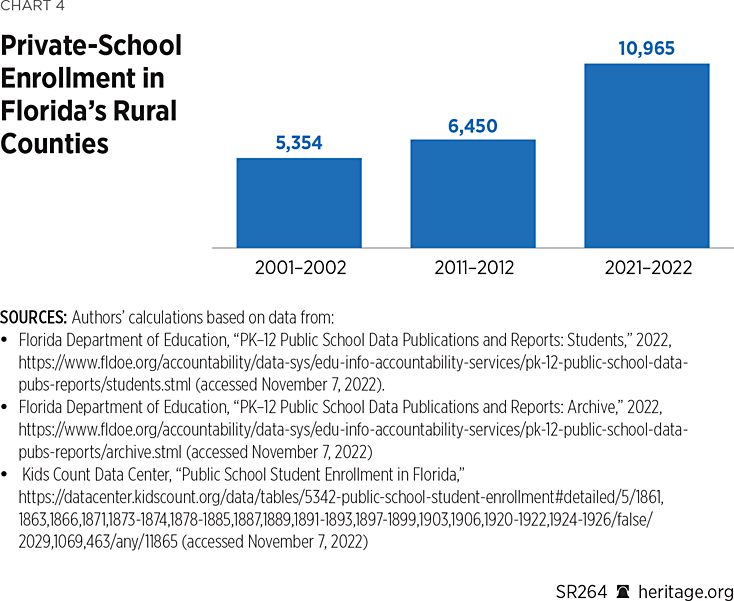
During the 2021–2022 academic year, nearly 180,000 Florida students statewide used a tax-credit scholarship, school voucher, or ESA to access the learning environment of their family’s choice.REF
Arizona is another state with robust education choice options that allow families to select private schools, including in rural areas. Nearly 7 percent of Arizona students use tax-credit scholarships or ESAs to access private learning options.REF Contrary to the assertion of school-choice opponents in Arizona that choice policies “provid[e] no benefit to rural communities,”REF thousands of rural students attend private schools using tax-credit scholarships.
Precise numbers are hard to come by in the Grand Canyon State as the Arizona Department of Education does not compile enrollment data for private schools. Moreover, other data sets do not disaggregate rural and non-rural enrollment. However, the available data suggest significant growth in private schooling in rural areas of Arizona over the past decade.
Seven Arizona counties are considered rural by the Federal Office of Rural Health Policy in the U.S. Department of Health & Human Services, the five largest of which have private schools.REF Over the past decade, the number of scholarships awarded in these rural counties more than doubled. As shown in Table 1, the number of tax-credit scholarships awarded in these rural counties grew by 163 percent since the 2010–2011 academic year. This increase tracks with the available private school enrollment data. As shown in Table 2, student enrollment in private schools doubled over the past eight years in the four rural counties for which data were available for both the 2021–2022 and 2013–2014 academic years.
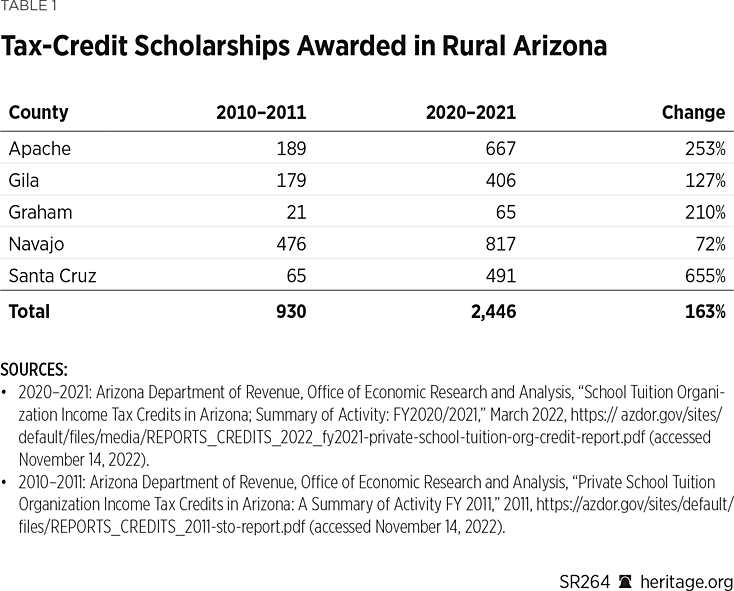
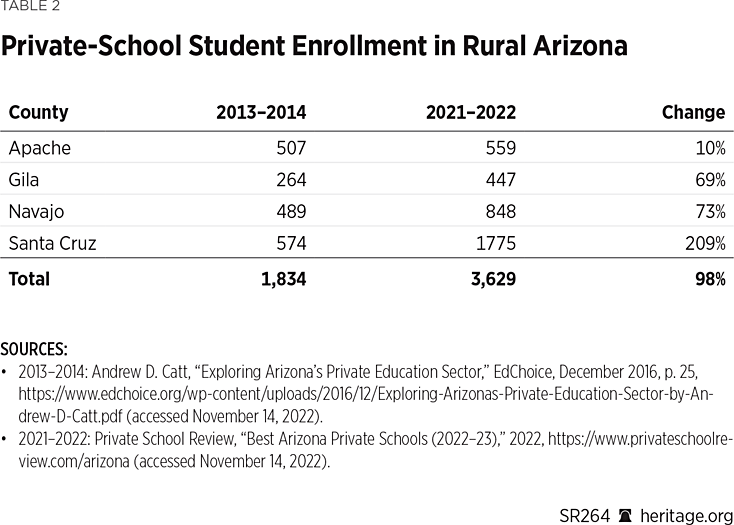
The growth in rural private school enrollment in Arizona over the past decade has not been driven by population growth. In fact, according to an analysis by The Arizona Republic, about “150 of the 230 public schools designated rural by the state have lost students since the 2011–2012 school year.”REF Moreover, as discussed at greater length in Part II, “[m]any of the schools considered rural that gained enrollment are charter schools, which have proliferated in the past decade in Arizona.”REF Overall, rural private school and charter school enrollment have increased in Arizona over the past decade as traditional public school enrollment has declined. Nevertheless, as discussed in Part II, academic performance in rural Arizona public schools has improved significantly more than the national average for rural schools over the same period.
States looking to expand access to private schooling in rural areas should follow the lead of Arizona and Florida by enacting education choice policies, such as ESAs and tax-credit scholarships.
Charter Schools. Charter schools are public schools that are privately operated under a charter granted by a state-approved authorizer. Charter schools have greater autonomy than district-run public schools and are freely chosen by parents. Forty-five states plus Washington, DC, have laws that allow charter schools.
Charter schools are considerably scarcer than private options in rural areas. Although all but a handful of states have enacted a charter school law, a combination of law and practice has concentrated the opening of charter schools in urban areas. According to the Brookings Institution, only 17 percent of rural families live within 10 miles of a charter school, compared to 59 percent of families nationwide.REF
Many charter school laws contain provisions preventing the opening of schools in rural areas. The Utah charter law, for instance, focuses approvals of new charter schools in areas with high levels of population growth.REF This may relieve district schools’ growing pains, but it limits the reach of charter schools in many areas of the state. Philanthropy further reinforced the trend as large foundations invested heavily in urban charter schools.REF
The legal and philanthropic focus on urban centers has induced charter school operators to likewise focus on large cities, which has limited growth in suburbs, towns, and rural communities. Chart 5 presents data from the National Alliance for Public Charter Schools on the location of district and charter schools nationwide by community type. Charter schools have well over twice the concentration in urban areas as districts do, less than half the presence of districts in towns and rural communities.REF
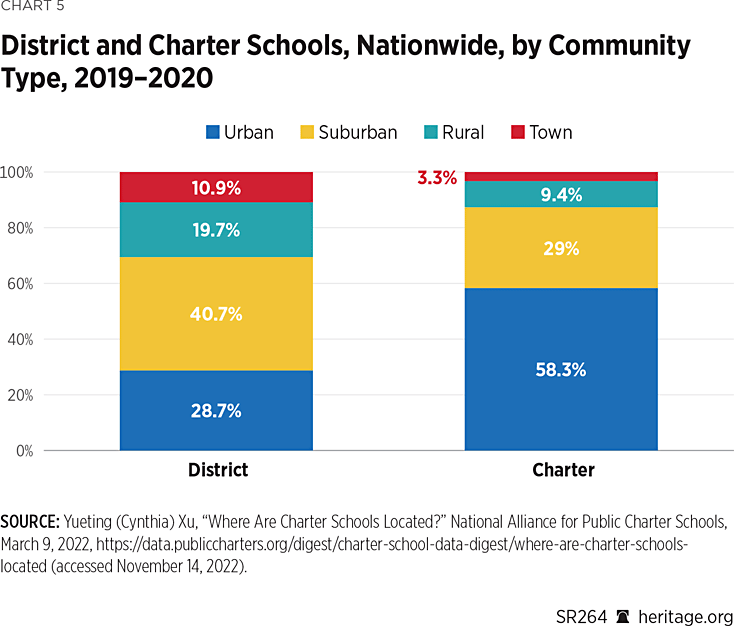
It need not be this way. Some states have a more robust charter school presence in rural areas, particularly where a state’s charter policy or its administration do not pose significant barriers to opening in rural areas. A 2016 study by the Brookings Institution measured the percentage of students in each state that have access to one or more charter schools in their zip code.REF Using data from the 2014–2015 school year, the Brookings study found significant variation across states in terms of families’ access to charter schools. As shown in Map 1, at 84 percent of students with one or more charter schools in their zip code, Arizona had the highest level of access by a wide margin.
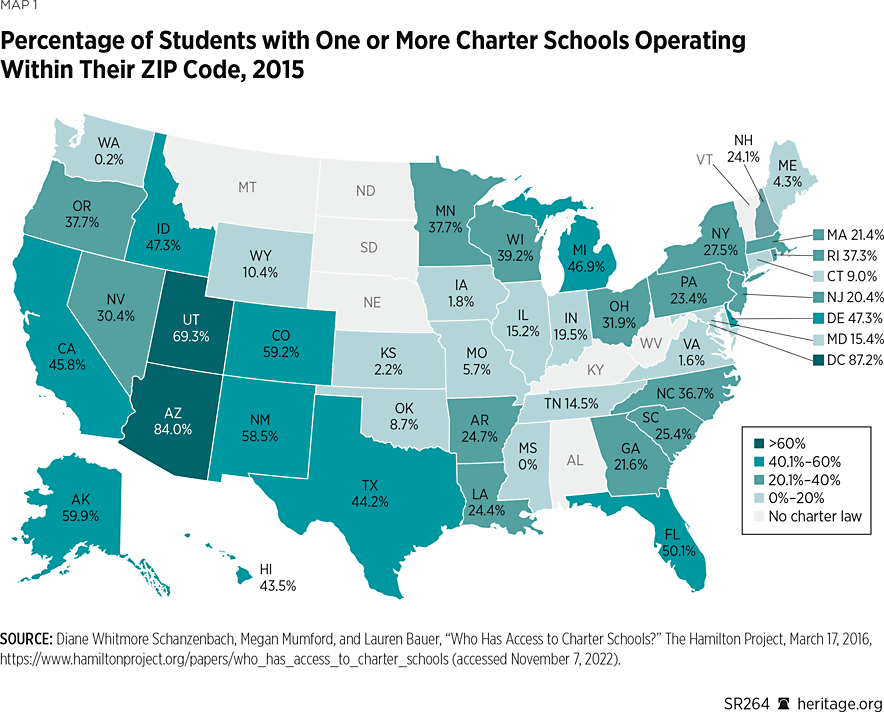
Arizona is a prime example of a state where charter schools are accessible in rural areas. As shown in Table 3, Arizona has more charter schools operating in rural areas (64) than the number of charter schools statewide in 16 states with charter school laws (Alabama, Alaska, Connecticut, Delaware, Hawaii, Iowa, Kansas, Maine, Maryland, Mississippi, New Hampshire, Oklahoma, Rhode Island, Tennessee, Washington, and Wyoming).
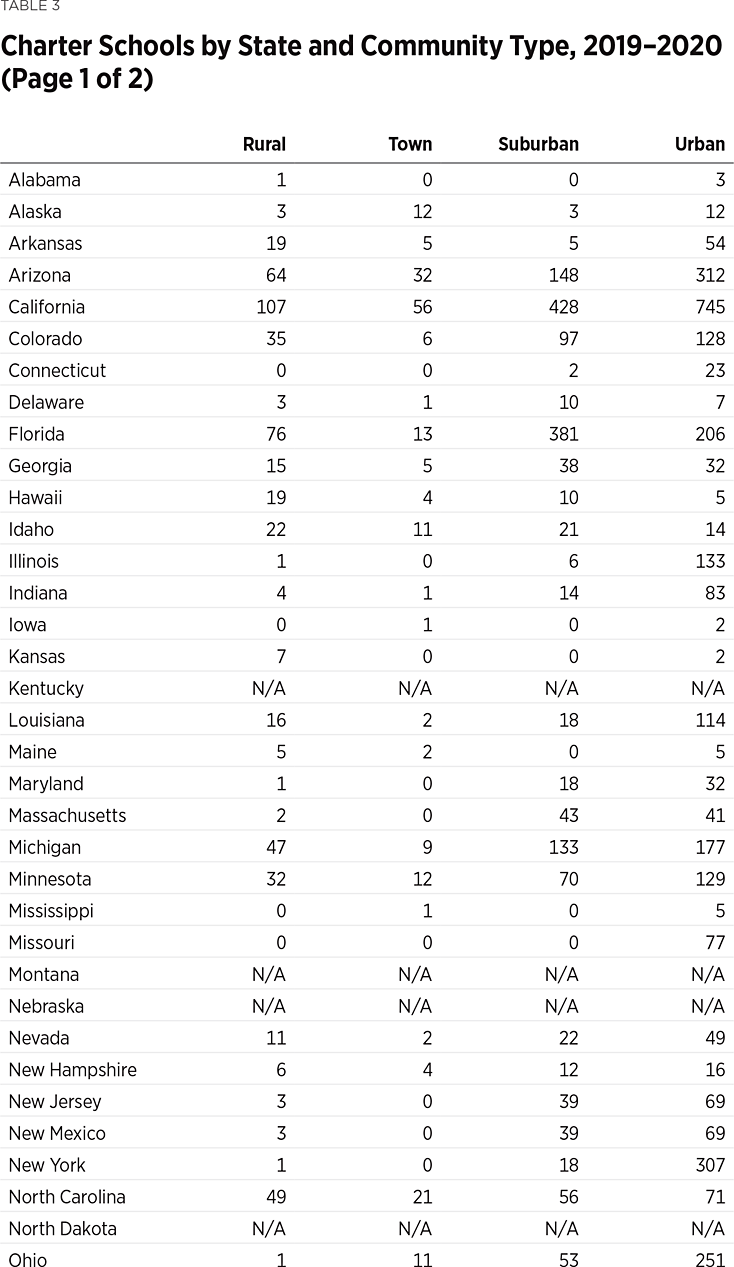
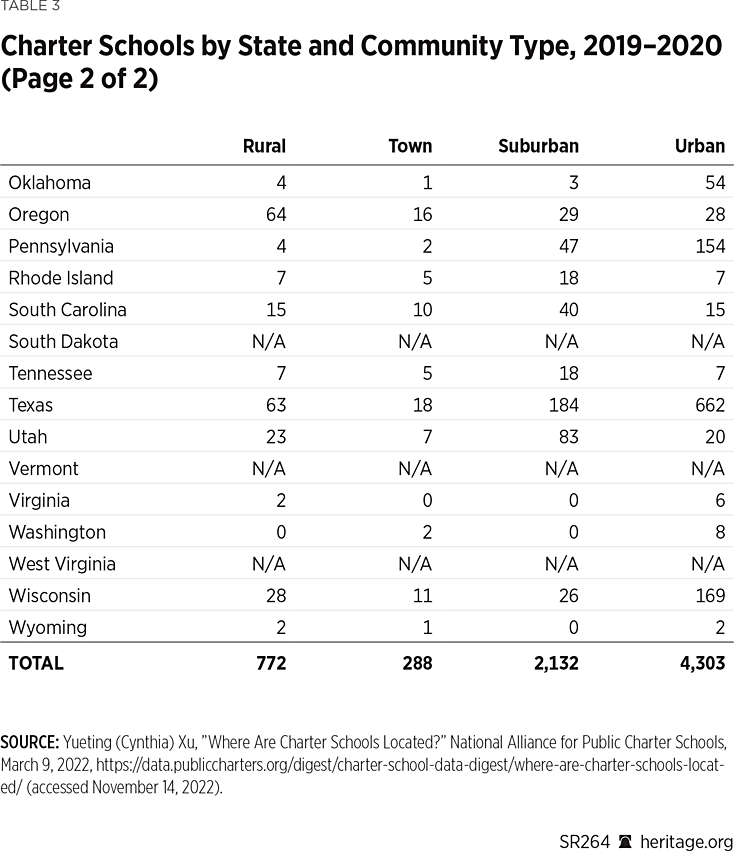
Mocked by some school choice critics as the Wild West of Charter SchoolsREF for supposedly making it too easy to open and operate charter schools, Arizona shows how prioritizing access need not come at the expense of quality. Arizona’s charter school sector, which serves predominantly Hispanic and black students, has led the nation in academic growth on the National Assessment of Educational Progress (NAEP)—also known as the Nation’s Report Card—over the past two decades. Moreover, Arizona’s charter schools also rank among the highest-achieving in the nation on the NAEP, with scores equivalent to New England statewide averages on all six 2015 NAEP exams (fourth-grade and eighth-grade math, reading, and science).REF In the most recent NAEP exams, taken after the impact of the COVID-19 pandemic in 2022, Arizona charter schools demonstrated scores on the eighth-grade math and reading exams that would rank first and second compared to statewide averages nationwide. Fourth-grade scores demonstrated the negative impact of the school shutdowns in being statistically indistinguishable from the statewide average scores. No science exams have been given since 2015 at the time of this writing.
The secret to Arizona’s success appears to be its approach to accountability. Most states take a top-down approach to accountability, making it difficult to open schools and then subjecting charter schools to significant oversight, with authorizers frequently shutting down schools that fail to meet certain objectives. By contrast, Arizona makes it easier to open charter schools and awards 15-year charters. The state takes a bottom-up approach to accountability, allowing more innovation and greater access to charter schools and relying on parents to shut down poorly performing schools by selecting better ones. As Matthew Ladner (co-author of this Special Report) explained in Education Next:
Administrative attempts to close charter schools are often met with fierce parental opposition and lawsuits, but when parents don’t like a school, they can simply vote with their feet, either by withdrawing their children from the school or by not choosing it in the first place. It is therefore parents, rather than state officials, who play the primary role in holding Arizona charter schools accountable, in a highly efficient manner. An abundance of K–12 opportunities—including charter schools, district schools, district open enrollment, magnet schools, and private choice programs—gives Arizona parents many exit options. Another key factor contributing to charter school closure may be that Arizona’s suburban districts, unlike those in many other states, are actively involved in accepting open-enrollment transfers.REF
Most Arizona charter schools that cease operation do so due to parents’ choices rather than a decision by authorizers. Among the 290 charter schools in Arizona that closed down between 2000 and 2013, the average enrollment in the final year of operation was only 62 students.REF The vast majority closed before their charters were scheduled for renewal. Indeed, for the schools for which data were available, the average length of operation of a school that ended up closing was only four years. By contrast, failing district schools tend to remain open forever. When parents have many options, they do not countenance poor performance very long.
Other states should expand opportunities for rural students to attend charter schools by removing regulatory barriers to opening and operating charter schools.
Microschooling. As with the term “rural,” there is no universally agreed-upon definition of a “microschool.” Generally speaking, microschools are small clusters of families that pool resources and collaborate to educate their children.REF They usually have an in-person instructor who teaches about five to 15 students, although some self-declared microschools enroll as many as 150 students.REF Often, though not always, they are affiliated with a larger organization or network of microschools, such as Acton Academy, Adamo Education, Kai Pods, or Prenda.
In a sense, microschools represent a 21st-century reimagining of the one-room schoolhouse—simultaneously innovative and yet deeply rooted in the nation’s history and culture. The original one-room schoolhouses were replaced by larger schools because they could not offer the same depth or breadth of study. But now, with the assistance of technology, microschools offer a comprehensive and rigorous education while providing a level of individual attention and personalization that larger schools struggle to achieve.
As with private schools generally, microschools vary significantly in terms of their pedagogical approach. Some take a classical approach. The Great Hearts Microschool network is affiliated with the popular Great Hearts classical charter school network that serves more than 22,000 students in Arizona and Texas.REF The network’s schools are organized according to the classical trivium—the grammar, logic, and rhetoric learning phases—and emphasize the pursuit of truth, goodness, and beauty. Likewise, the Ecclesial Schools Initiative in Florida “envisions an expanding network of affordable Christian classical schools based in churches and catering primarily to families using state-supported school choice scholarships.”REF
In a sense, microschools represent a 21st-century reimagining of the one-room schoolhouse—simultaneously innovative and yet deeply rooted in the nation’s history and culture.
Other microschools take a more self-directed approach. For example, Acton Academies take children on a “hero’s journey,” using Socratic discussions, project-based learning, and real-life apprenticeships to help students to become “curious, independent, lifelong learners.”REF Founded in Austin, Texas, in 2009, Acton Academies now operate over 200 microschools in the United States and abroad. Wildflower Schools grew out of an MIT Media Lab research project in Cambridge, Massachusetts, into more than 60 microschools across more than a dozen states in 2014. Wildflower Schools offers a Montessori approach that combines elements of institutional and homeschooling.REF
Microschools received much more attention when schools nationwide were suddenly closed for in-person instruction in the spring of 2020. When desperate parents found themselves looking for in-person instruction with small class sizes to limit potential exposure to the coronavirus, microschools offered exactly what many families needed. But even before the pandemic, microschools were already on the rise because they offer greater flexibility, customization, and personalized instruction.
Microschools are especially popular in states like Arizona, where state policies made it easier for them to open and grow. The Prenda microschool network was founded by Kelly Smith in 2018 with just a handful of students. Prenda offers student-directed learning organized around three “modes”—Conquer, Collaborate, and Create—during which students make progress in core academic subjects, learn to work together, and do projects related to science, technology, engineering, and math (STEM), history, the arts, and more.REF Each Prenda microschool is run by a “guide” (more like a mentor or coach than a traditional teacher) with classrooms of between five and 10 students. By the 2019–2020 academic year, Prenda had already grown to nearly 900 students in about 100 microschools across Arizona. During the pandemic, it doubled enrollment, growing to 1,827 students in 2022–2023 in Arizona.REF Prenda now serves more than 3,000 students in more than 300 microschools in six states.REF
A part of what made it possible for Prenda to expand so quickly was Arizona’s school-choice policies. Some families access Prenda by paying with their state-issued ESAs. Others access Prenda via its partnership with local district schools or EdKey, an online charter school, which means they do not pay out of pocket at all. Prenda microschools have operated in some of the most rural parts of Arizona, including the Apache and Navajo tribal lands as well as Colorado City. From the 2019–2020 school year to the 2022–2023 school year, Prenda enrollment in rural areas grew by 26 percent, from 367 to 464 students.REF
Microschools have much potential to meet the educational needs of rural families. As Arizona has demonstrated, when states embrace policies that allow parents to choose the learning environments that work best for their children, it makes it easier for innovative options like microschools to take root and grow.
Virtual Learning. In the wake of the COVID-19 pandemic, virtual schooling (also called online schooling, distance learning, or remote learning) took a hit to its reputation, especially as evidence mounted that children learning remotely instead of receiving in-person instruction were suffering significant learning loss.REF Nevertheless, brick-and-mortar schools attempting to replicate their classroom experiences on Zoom during an emergency should not be conflated with intentional virtual schooling.
A 2020 survey found that parents of children enrolled in virtual schools were much more likely to report that their children “learned a lot” (86 percent) than parents of children enrolled in brick-and-mortar schools that were utilizing remote learning (13 percent).REF The survey also asked parents about their school’s performance across four constructs: active learning, communication, pedagogical efficacy, and classroom management. The survey found that parents of students enrolled in virtual schools were “significantly more likely to report that their child engaged in activities associated with active learning, and they agreed that virtual schools outperformed brick and mortar schools when it comes to clear communication, classroom management, and sound instructional practices.”REF
It is no wonder, then, that parents are increasingly supportive of virtual schooling. In the 2022 Education Next survey, 64 percent of parents said that they would be willing to let their child take some academic courses online, up from 56 percent in 2009.REF
During the pandemic, virtual schools saw a sharp uptick in enrollment. Stride K12, the nation’s largest virtual charter school operator, saw enrollment grow nearly 40 percent in 2020, up to about 170,000 students nationwide compared to about 123,000 students in 2019.REF The nation’s second-largest virtual school network, Connections Academy, reported that its applications had increased by more than 60 percent in 2020.
Although no government agency collects data on where virtual school students live, there is evidence that virtual schools disproportionately serve students in rural areas. As noted, the National Center for Education Statistics reports that about 15 percent of public school students live in rural areas.REF By contrast, a survey of Stride K12 virtual school families finds that 38 percent live in a rural area.REF In Arizona, rural enrollment in EdKey’s virtual charter school increased more than fivefold over the last decade, from 724 in 2012 to 3,785 in 2022.REF During the COVID-19 pandemic in 2020, EdKey’s rural enrollment spiked to about 4,300 students.
Families choose virtual schools for a variety of reasons. Often, they are attracted to the flexible scheduling that it offers, especially for students with special needs, health concerns, or those involved in elite sports, acting, or similar activities. One mother told a local news affiliate in Atlanta that she chose a virtual school for her son so that he could participate in a special program with the Atlanta Ballet: “Because he dances in the day, he needed a fully asynchronous, fully virtual option that would allow him to kind of pursue his passion, but also, you know, do high school.”REF Virtual schools allow students to learn at their own pace and on their own schedule.
Virtual schools also offer a variety of courses that might not be offered in a student’s local school, particularly in rural areas. Not all brick-and-mortar schools offer Advanced Placement courses, classes in a wide variety of foreign languages, or specialized programs in STEM or computer programming. Virtual schools can provide access to courses that students might not be able to attend locally.
Of course, access to virtual learning depends on access to high-speed Internet. Rural residents have more difficulty accessing high-speed Internet than suburbanites and city dwellers, but most report that they do have high-speed access. A 2021 survey by the Pew Research Center found that 72 percent rural Americans said they have a broadband Internet connection at home, compared to 77 percent and 79 percent for urban and suburban residents, respectively.REF Rural access to high-speed Internet increased by nine percentage points since 2016. In the not-too-distant future, high-speed Internet might be accessible even in the remotest rural areas due to technological advances, such as Elon Musk’s Starlink satellite Internet service.REF
Some virtual schools are even beginning to use virtual reality to enhance their students’ learning experience. For example, Optima Classical Academy (OCA) in Florida is the first—and so far, only—classical virtual charter school. OCA opened its virtual doors this year and serves students in grades three through eight. Like other classical schools, OCA focuses on delivering “rich content which fosters a natural love for learning and thinking.”REF As OCA’s founder and CEO, Erika Donalds, explains:
Students learn about historical events, characters, stories, fables, poetry, scientific facts, and mathematical proofs. They read the classics as whole books in great depth and learn to approach books both with motivation to learn and courage to question. The principles of moral character and civic virtue, now absent from most public school classrooms, are fundamental to the classical curriculum.REF
However, unlike most classical schools, OCA employs virtual reality to create “an immersive, collaborative, and socially appropriate experience with their instructor and peers unlike any other virtual school available.”
On our virtual reality platform, scholars are immersed together as avatars in a traditional-looking and -feeling VR classroom and can be transported again to whatever learning environment is relevant to the lesson. For example, while our 3rd grade scholars are reading The Whipping Boy, they can be in a castle setting, more closely aligned with the context and setting of the book. Marine biology studies can be done underwater. A study of the United States Constitution can include a visit to the Constitutional Convention. This additional element of learning leads to deeper understanding and better Socratic discourse.REF
Virtual learning might not be the right fit for every child. But for some, it opens a world of possibilities that they otherwise do not have locally—all without having to leave the rural community that they know and love.
Part II: Effects of Education Choice Policies on Rural Public Schools
Clearly there are more education options in rural areas than skeptics of education choice claim. Yet the wider availability of options might lend credence to their second (albeit contradictory) claim, that a wide availability of education options harms rural public school districts. As anti-school-choice groups, like Save Our Schools Arizona, put it, while education choice policies supposedly “drain resources from all public schools, they disproportionately hurt rural public schools.”REF Others go further, predicting that choice policies would create a “death spiral” as families use the choice policies to move their children out of the public school system. As Kathryn Joyce wrote in Salon, citing Network for Public Education executive director Carol Corbett Burris:
“When that happens, especially in rural areas, if enough kids leave the system, they leave behind all kinds of stranded costs,” said Burris. Schools will still have to pay staff and keep the lights on, but will receive substantially less support to do so. “Then you have a vicious cycle, where the quality of education in public schools starts to suffer, which means more people leave, and the more people leave, the more the quality of education deteriorates.”REF
Although 25 of the 28 empirical studies on the effects of education choice policies on public school performance find positive effects, some critics worry that supposed negative effects in rural areas are being masked by the positive effects in urban and suburban areas.REF If there is anywhere to test this thesis, Arizona—which has a robust education choice environment, with more than one-third of its K–12 students in rural areas—is the place to examine.REF
Arizona has consistently ranked as one of the top states for education freedom and choice over the past two decades. Arizona first claimed this title in a 2002 study that ranked all 50 states for education freedom.REF The report considered states’ policies on district open enrollment, charter schools, homeschooling, and private school choice. In 2021, a replication of this study with more recent data ranked Arizona first in education freedom again.REF In 2022, The Heritage Foundation’s inaugural Education Freedom Report Card ranked Arizona number two overall (behind Florida) and number one for education choice.REF Arizona has the highest percentage of K–12 students participating in education choice (7 percent) and the second-highest percentage enrolled in charter schools (19 percent) of any state.REF
Arizona has consistently ranked as one of the top states for education freedom and choice over the past two decades.
As noted, 84 percent of students in Arizona have access to at least one charter school in their zip code—the highest percentage in the nation by a wide margin. The state with the next-highest charter school accessibility rate is Utah, but the Beehive State’s law focuses charter school expansion on communities with high enrollment growth. Moreover, Utah’s private choice programs are restricted to students with special needs. Alaska, Colorado, and New Mexico come next for breadth of reach of their charter sectors, but none of these states have private choice programs. Florida had one or more charter schools operating in half of its zip codes, as well as robust private choice programs. However, Arizona’s charter sector reaches 34 percent more zip codes than Florida’s. In short, Arizona’s choice sectors reach further into rural areas than in any other state.
Arizona lawmakers passed a charter school law and an open enrollment statute in 1994, and three years later they passed the nation’s first tax-credit scholarship program. Under the original program, individual taxpayers can donate to a nonprofit organization and receive a dollar-for-dollar tax credit against their state income tax. The scholarship organization collects these funds and grants scholarships to students to attend private schools. In subsequent years, Arizona lawmakers have repeatedly increased the size of the credit and created new credits against corporate income taxes. The Arizona Department of Revenue tracks the number of scholarships and the dollar amounts by county in Arizona. All but the two smallest counties in Arizona (Greenlee and LaPaz) have tax-credit scholarship students. Neither Greenlee nor LaPaz currently have a private school in operation.
Are Arizona’s rural school districts withering and dying because of school choice, as the critics predicted? Hardly. The National Center for Education Statistics listed 224 regular school districts in Arizona in 1993, the year before choice began. In 2019, the same source listed 226 Arizona regular school districts.REF Since the advent of choice in Arizona, there have been consolidations of rural districts in two counties, the closure of a district in a country without charter or private schools, and one new district created. The overall picture is of relative stability. The news of rural school districts dying because of choice seems to have been greatly exaggerated.
Of course, it is possible for schools to be harmed without shutting down. It could be the case that the rural districts have academically suffered despite their continued existence. Fortunately, the data belie such concerns. The NAEP tests samples of students at the state level and allows the tracking of academic trends in fourth-grade and eighth-grade math, reading, and science.
Charts 6 and 7 show both pre-pandemic and post-pandemic NAEP data for rural students in Arizona and the United States. On the math and reading exams, 10 points approximately represents a grade-level’s worth of progress. (Thus one expects a group of fifth-graders to score 10 points higher than a similar group of fourth-graders.) The science exams use a different scale than the math and reading exams, so this rule of thumb does not apply. For each test, the earliest available result (2007 for math and reading, 2009 for science) is subtracted from the most recent pre-pandemic result (2019 for pre-pandemic math and reading scores, 2015 for science) for both Arizona and the United States as a whole. Chart 6 presents the data for each test for the longest period available until the COVID-19 pandemic and corresponding school shutdowns (2007 to 2019 for the math and reading tests, 2009 to 2015 for the science results).
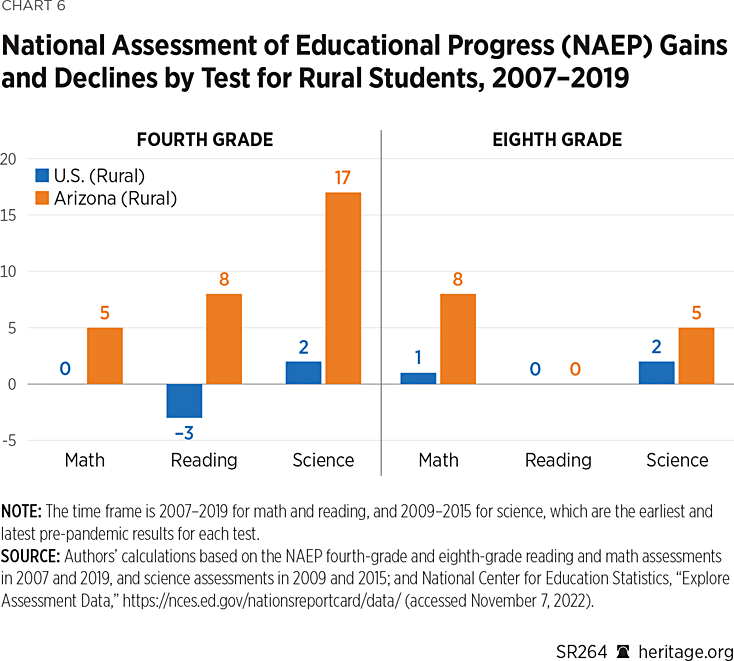
The pre-pandemic NAEP scores show no evidence that education choice harms rural schools. Quite to the contrary, rural Arizona students demonstrated progress on five of the six academic exams, often by wide margins. On the sixth exam, Arizona rural students matched the national trend. Although NAEP scores alone cannot prove that Arizona’s choice policies led to the increase in academic performance, they nevertheless provide strong evidence against the hypothesis that education choice causes harm.
The NAEP scores show no evidence that education choice harms rural schools. Quite the contrary.
In September 2022, the NAEP released the first post-pandemic scores in fourth-grade and eighth-grade math and reading. The results around the nation were devastating. On the long-term trend assessment, math performance fell for the first time in the test’s history while students’ reading scores showed the biggest declines in 30 years.REF The main NAEP scores released in October also showed “unprecedented declines in math and significant dips in reading achievement.”REF Yet, as shown in Chart 7, although Native American populations in rural parts of Arizona were especially hard hit by the COVID-19 pandemic, Arizona’s rural NAEP trends remained favorable compared to the nation as a whole.
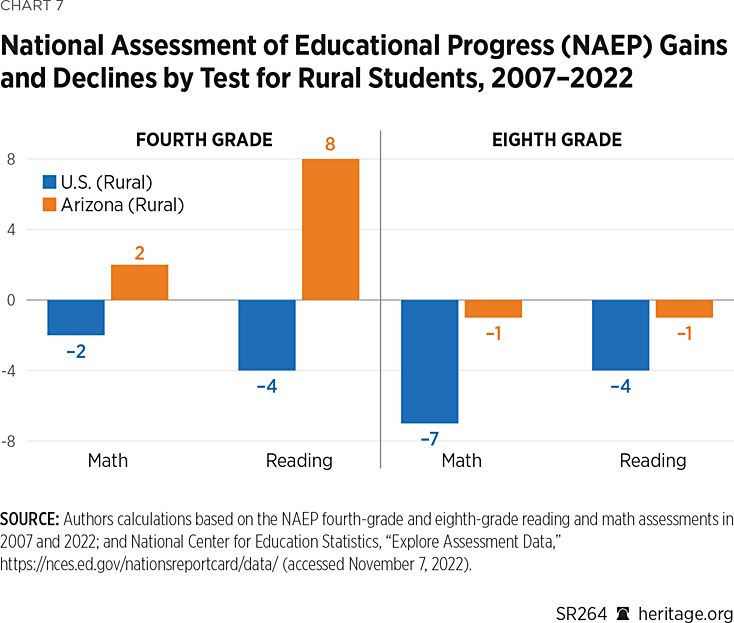
The NAEP gives examinations to random samples of students across states, creating the possibility of sampling error for student subgroups. A group of Stanford scholars, however, has created a data source based on state academic examinations, and thus with a much broader set of information. Stanford University’s Educational Opportunity Project has linked state testing data across the country and includes measures of academic growth for the 2008–2018 school year by state, county, school district, and individual public school (private schools are not included). Arizona shows the highest statewide rate of academic growth overall, as well as the highest rates for low-income students (by a wide margin) and for middle-income and high-income students (narrowly).REF
Arizona’s rural schools, districts, and counties also show high levels of academic growth. In fact, rural Santa Cruz County shows the highest rate of academic growth of any county in Arizona—an annual average of 17 percent more learned per year above a single grade level. Charter schools contributed directly to this high level of academic growth. Arizona’s rural charter school students averaged a rate of annual learning 20 percent above a single grade level per year.REF
The Arizona experience with rural school choice since 1995 does not support the notion that school choice will “destroy” or even damage rural education outcomes. Indeed, Arizona’s results indicate that it is more likely that rural students and families benefit from having access to a wide variety of learning options.
Conclusion
Rural areas have far more education options than the opponents of education choice claim. Private schools, charter schools, microschools, and virtual learning are accessible to most students in rural areas and policymakers can expand access by enacting robust education choice policies. Additionally, Arizona’s experience shows that education choice policies spur the creation of new options and the expansion of existing ones, including in rural areas.
Moreover, contrary to the scaremongering by opponents of education choice, there is no evidence that the expansion of education options in rural areas has any negative effects. Indeed, the best available evidence suggests that choice and competition are the rising tide that lifts all boats, including in rural areas.
Education choice can also be a very popular policy initiative in rural areas. As noted, Texas Republican primary voters supported a ballot proposition endorsing education choice by a margin of 88 percent to 12 percent. In several of the most rural parts of Texas, voters supported education choice with between 87 percent and 100 percent of the vote. Likewise, in Oklahoma, a 2022 survey found that 70 percent of rural Oklahomans supported school choice, while only 25 percent opposed it.
Rural families whose children are not well served by their assigned school often face the difficult choice between subpar education and leaving the community they love. Rural families who have access to a wide variety of high-quality education options are more likely to stay and avail themselves of those options.
Policymakers who want to expand access to education options in rural parts of their state should:
- Enact universal K–12 ESAs. ESAs empower families with the freedom and flexibility to customize their children’s education. Families can use ESAs to pay for private school tuition, microschooling, virtual learning, tutoring, textbooks, homeschool curricula, transportation, and more. Families can even roll over unused funds to save for future education expenses. ESAs can provide rural families with access to a wider variety of education options and create an incentive for education providers to serve rural areas.
- Expand charter school policies. Policymakers should make it easier to open and operate charter schools, generally, and in rural areas, specifically. States with restrictive, top-down regulations tend to have very few charter schools. In a misguided effort to ensure quality, they too often make charter schools inaccessible. By contrast, states like Arizona prioritize accessibility, making it easier to open charter schools and relying on bottom-up, parent-driven accountability to ensure quality. Policymakers should reduce barriers to entry for charter operators, allow multiple charter authorizers, grant longer charters, and reduce red tape.
No one school can best meet the needs of all the children who just happen to live nearby. Families living in rural areas deserve more education options. By embracing education choice policies, state lawmakers can deliver on the promise of America’s education system and ensure that all children have access to the learning environment that best meets their individual needs and helps them to achieve their full potential.
Jason Bedrick is Research Fellow in the Center for Education Policy at The Heritage Foundation. Matthew Ladner, PhD, is Director of the Arizona Center for Student Opportunity at the Arizona Charter School Association.



